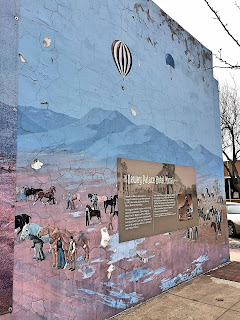Rebecca
L. Fisk
Nampa
Street Art – A Brief Overview
“Open
Invitation” by Idaho-native Lauren Kistner is one of the many
art-wrapped utility boxes sponsored by the cities of Nampa and Boise
as part of their “art in public” initiatives. The original
painting is watercolor paint and ink mixed media. The designs for
these traffic utility signal wraps were professionally printed and
wrapped on a sticky plastic material and applied to the boxes
similarly to a graphics car wrap. Kistner's work from this series is
based on the geothermal activity and other natural phenomenon that
occurs throughout the state of Idaho. I love the texture and
combinations of techniques and colors she uses. They truly emulate
the landscape in Yellowstone, the deserts around Boise, and the
mountains and waterways throughout the state.
“Open
Invitation” by Idaho-native Lauren Kistner is one of the many
art-wrapped utility boxes sponsored by the cities of Nampa and Boise
as part of their “art in public” initiatives. The original
painting is watercolor paint and ink mixed media. The designs for
these traffic utility signal wraps were professionally printed and
wrapped on a sticky plastic material and applied to the boxes
similarly to a graphics car wrap. Kistner's work from this series is
based on the geothermal activity and other natural phenomenon that
occurs throughout the state of Idaho. I love the texture and
combinations of techniques and colors she uses. They truly emulate
the landscape in Yellowstone, the deserts around Boise, and the
mountains and waterways throughout the state.
Known
simply as “The Horse Mural,” according to Nampa's City website
and “Galloping Horses” according to “Waymarking”, a website
devoted to cataloging sites around the world, this bas relief
sculpture takes up the entire length and most of the height of the
Yesteryear Shoppe in downtown Nampa on the corner of 12th
Avenue and 1st Street South. Indicated as
approximately 15 by 60 feet and possibly made of fiberglass, the
mural is unfortunately not cited or recognized by any official source
and artist is unknown. It's nevertheless famous, as all asked
residents nod and say, “Yes, the horse mural! It's pretty cool, but
no, I don't know who did it.”
The
Dewey Palace Hotel Mural was originally painted in 1984 by artists
Eva Johnston, Olivia Vincent, Mary Van De Bogart and Sue Wilhelm in
1984. Commissioned by the city in celebration of the Nampa
Centennial, the image depicts the famous Dewey Palace in it's
imagined glory days of the early 1900's. Also showcasing some of the
technology of the time, the motor car, the airplanes, and in the far
right corner, a red-roofed vendor's push cart for the tourists. The
mural was restored in 1991 by artists Ava Race, Doris Cusic, Joy
Tuckness and returning artists Eva Johnston and Olivia Vincent, and
then the vinyl printed overlay in 2012 by the Nampa Arts Commission.
You can see the portions of the original mural and the fine detail
and soft color versus the print limitations of the vinyl overlay but
it is helping temporarily preserve the original piece and its
historical significance.
This
mural by Candis Redfield (Darrah) is painted on the backside of one
of Nampa's most famous businesses, The Flying M Coffee Garage. Candis
is a local Nampa resident and this piece was part of the 2014 Nampa
Art Collective's public art initiative. Candis is a mixed media
artist and in this piece, she identifies it as symbolizing “our
community and what the future holds for us. I wanted to capture the
young generations striving for a better future that involves
sustainability and our love for the environment” (Idaho Statesman,
July 2014). In choosing to create a narrative with a limited color
range, the artist is effectively highlighting the “black and white”
simplicity of Idaho's past, with it's mining and farming cultures,
with the new reality of our future being open and undefined in open,
blue skies, under which sits a contemplative youth holding a single
yellow flower of hope who has just parachuted out of a plane. The mix
of nostalgia, present, and future is a great analogy for Idaho, and
Nampa in particular.
This
sculpture is untitled and by an anonymous artist. I'm calling it
“Garbage” so I can mention that “Garbage” as art is
concealing garbage as function, i.e. the dumpster outside a cafe
downtown. I love this piece. It's mixed media, mostly metal pieces
soldered and welded together in various stages of rust and aged
paint. The patina is just gorgeous. Many of the metal pieces have
corrugated or dimpled texture and the veins of rust etching through
the paint creates a beautiful merging of nature and technology, decay
leading to new creations. The sculpture is approximately 36 by 72
inches, sitting atop metal pipes about 10-12 inches tall.






Comments
Post a Comment